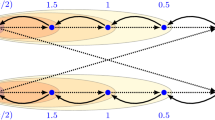Abstract
In this paper new lower bounds for the Symmetric Travelling Salesman Problem are proposed and combined in additive bounding procedures. Efficient implementations of the algorithms are given; in particular, fast procedures for computing the linear programming reduced costs of the Shortest Spanning Tree (SST) Problem and for finding all ther-SST of a given graph, are presented. Computational results on randomly generated test problems are reported.
Similar content being viewed by others
References
A.V. Aho, J.E. Hopcroft and J. Ullman,The Design and Analysis of Computer Algorithms (Addison-Wesley, Reading, MA, 1974).
E. Balas and N. Christofides, “A restricted Lagrangian approach to the Traveling Salesman Problem,”Mathematical Programming 21 (1981) 19–46.
G. Carpaneto, M. Dell'Amico, M. Fischetti and P. Toth, “A branch and bound algorithm for the Multiple Depot Vehicle Scheduling Problem,”Networks 19 (1989).
G. Carpaneto, S. Martello and P. Toth, “Algorithms and codes for the Assignment Problem,” in: B. Simeone, P. Toth, G. Gallo, F. Maffioli and S. Pallottino, eds.,FORTRAN Codes for Network Optimization, Annals of Operations Research 13 (1988) 193–223.
N. Christofides, “The shortest Hamiltonian chain of a graph,”SIAM Journal on Applied Mathematics 19 (1970) 689–696.
E.W. Dijkstra, “A note on two problems in connexion with graphs,”Numerische Mathematik 1 (1959) 269–271.
J. Edmonds, “Optimum branchings,”Journal of Research of the National Bureau of Standards 71B (1967) 233–240.
M. Fischetti and P. Toth, “An efficient algorithm for the Min-Sum Arborescence Problem,” Technical Report OR/87/7, DEIS, University of Bologna (Bologna, 1987).
M. Fischetti and P. Toth, “An additive approach for the optimal solution of the Prize-Collecting Travelling Salesman Problem,” in: B. Golden and A.A. Assad, eds.,Vehicle Routing: Methods and Studies (North-Holland, Amsterdam, 1988) pp. 319–343.
M. Fischetti and P. Toth, “An additive bounding procedure for combinatorial optimization problems,”Operations Research 37 (1989) 319–328.
M. Fischetti and P. Toth, “An additive bounding procedure for the Asymmetric Travelling Salesman Problem,” submitted toMathematical Programming (1990).
B. Gavish and K. Srikanth, “An optimal method for large-scale multiple traveling salesman problems,”Operations Research 34 (1986) 698–717.
K. Helbing Hansen and J. Krarup, “Improvements of the Held-Karp Algorithm for the Symmetric Traveling-Salesman Problem,”Mathematical Programming 7 (1974) 87–96.
M. Held and R.M. Karp, “The Traveling-Salesman Problem and minimum spanning trees,”Operations Research 18 (1970) 1138–1162.
M. Held and R.M. Karp, “The Traveling-Salesman Problem and minimum spanning trees: Part II,”Mathematical Programming 1 (1971) 6–25.
J.B. Kruskal, “On the shortest spanning subtree of a graph and the Traveling Salesman Problem,”Proceedings of the American Mathematical Society 7 (1956) 48–50.
E.L. Lawler,Combinatorial Optimization: Networks and Matroids (Holt, Rinehart and Winston, New York, 1976).
E.L. Lawler, J.K. Lenstra, A.H.G. Rinnooy Kan and D.B. Shmoys,The Traveling Salesman Problem: A Guided Tour of Combinatorial Optimization (Wiley, Chichester, 1985).
M.W. Padberg and M. Grötschel, “Polyhedral computations,” in: E.L. Lawler, J.K. Lenstra, A.H.G. Rinnooy Kan and D.B. Shmoys, eds.,The Traveling Salesman Problem: a Guided Tour of Combinatorial Optimization (Wiley, Chichester, 1985).
M.W. Padberg and G. Rinaldi, “Optimization of a 532-City Symmetric Traveling Salesman Problem by branch and cut,”Operations Research Letters 6 (1987) 1–8.
R.C. Prim, “Shortest connection networks and some generalizations,”BSTJ 36 (1957) 1389–1401.
T.H.C. Smith and G.L. Thompson, “A LIFO implicit enumeration search algorithm for the Symmetric Traveling Salesman Problem using Held and Karp's 1-tree relaxation,”Annals of Discrete Mathematics 1 (1977) 479–493.
R.E. Tarjan, “Finding optimum branchings,”Networks 7 (1977) 25–35.
T. Volgenant and R. Jonker, “A branch and bound algorithm for the Symmetric Traveling Salesman Problem based on the 1-tree relaxation,”European Journal of Operational Research 9 (1982) 83–89.
T. Volgenant and R. Jonker, “The Symmetric Traveling Salesman Problem and edge exchanges in minimal 1-trees,”European Journal of Operational Research 12 (1983) 394–403.
Author information
Authors and Affiliations
Rights and permissions
About this article
Cite this article
Carpaneto, G., Fischetti, M. & Toth, P. New lower bounds for the Symmetric Travelling Salesman Problem. Mathematical Programming 45, 233–254 (1989). https://doi.org/10.1007/BF01589105
Received:
Revised:
Issue Date:
DOI: https://doi.org/10.1007/BF01589105




